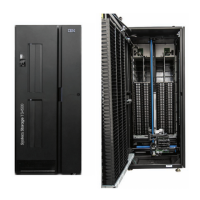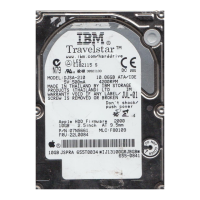between source volume A and target volume B. Data loss occurs on source volume
A. To keep applications running, you can reverse the FlashCopy relationship so that
volume B is copied to volume A.
Note: A fast reverse option that applies to a Global Mirror operation allows a
FlashCopy relationship to be reversed without waiting for the background
copy of a previous FlashCopy relationship to finish. A Global Mirror operation
is based on existing Global Copy and FlashCopy operations at the target
site.
Figure 8 illustrates how a reverse restore operation works:
FlashCopy to Metro Mirror source volumes
You can use an existing Metro Mirror source volume as a FlashCopy target volume.
This process allows you to create a point-in-time copy and then make a copy of that
data at a remote site.
Previously, you could create a FlashCopy relationship between two volumes and
then create a Metro Mirror volume pair by using the FlashCopy target volume as
the Metro Mirror source volume. However, you could not use an existing Metro
Mirror source volume as a FlashCopy target volume. This is no longer a restriction.
You can create FlashCopy target volumes that serve as production volumes and
mirror them to a remote site usingMetro Mirror.
You can create a full volume or incremental point-in-time copy to an existing Metro
Mirror source volume. The first time that you create a FlashCopy operation, the
entire Metro Mirror source volume has to be copied to the remote site, similar to a
new pair being established. Afterwards, provided that you created the FlashCopy
volume pair with the persistent and change recording options, you can perform a
refresh (incremental) of the FlashCopy relationship. The refresh copies only
changes and sends them to the remote site, requiring less time for the remote
mirror and copy volumes to be synchronized again.
When you create a FlashCopy operation and the logical copy finishes, the
corresponding Metro Mirror volume pairs turn to duplex pending status as long as
FlashCopy initiated from Volume A to
Volume B.
olumes.
Change recording starts
on both v
Once FlashCopy is established, the
P-i-T copy is available, and Volume A
and Volume B can start receiving updates
Background copy task copies data
from Volume A to Volume B.
Reverse restore initiated from
Volume B to Volume A:
Background copy task copies
from Volume B
and Volume A to Volume A.
updated tracks
Change recording reset to track
new changes (ready for the next
incremental FlashCopy request).
Time
volA
volB
volA
volB
volA
volB
volA
volB
1tytax
Figure 8. Refreshing target volume — reverse restore
112 DS8000 User’s Guide
